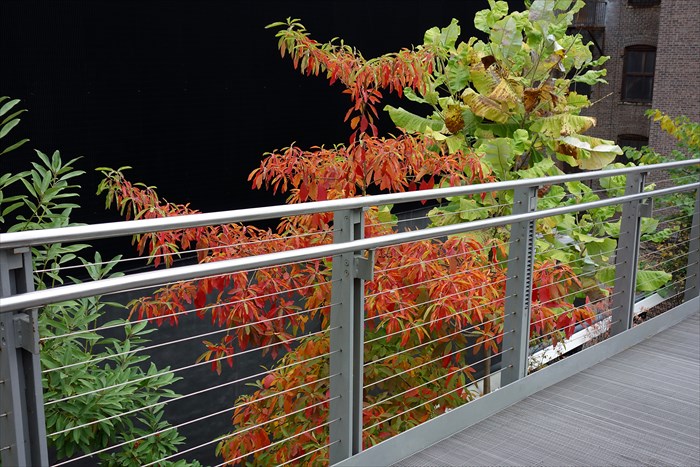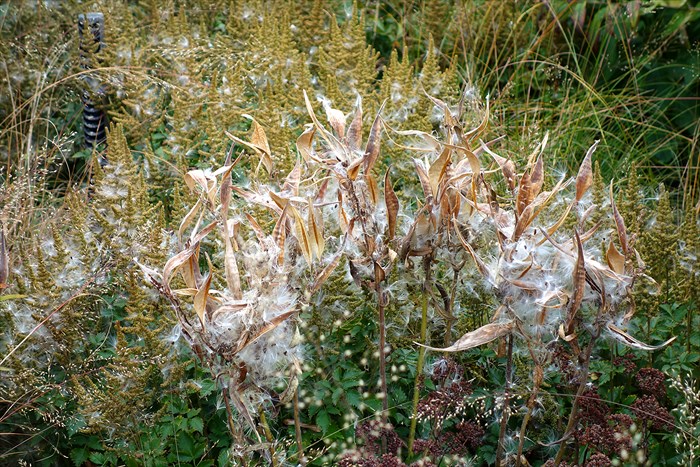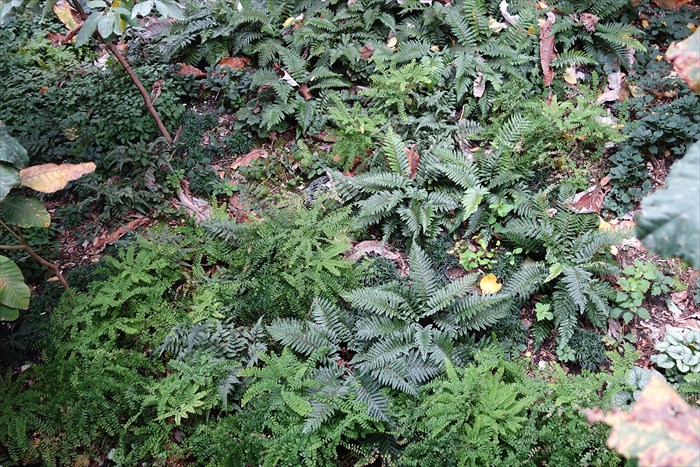On the High Line: The Third Landscape with Gilles Clement and Michael Gordon

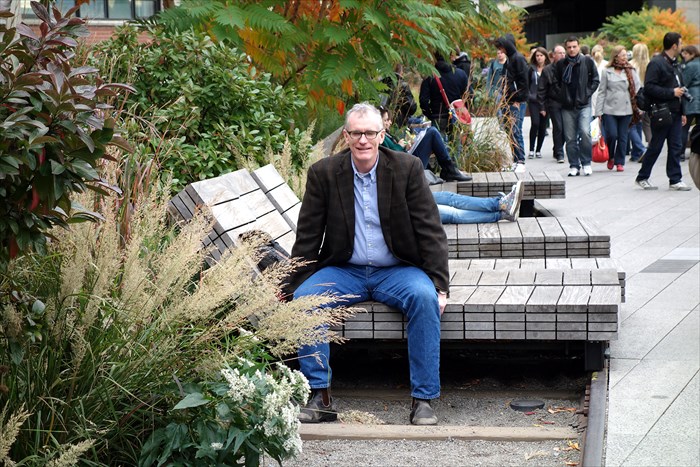 In late October I was fortunate to join Michael Gordon for a walk on the High Line. He planned to come to New York for a lecture by Gilles Clement, which I intended to go to too, so we arranged to meet. We had the opportunity to talk about the changes in the High Line since its opening, and to observe how the plantings have developed over those years. (See the photos below because I'll be silent on that matter.)
In late October I was fortunate to join Michael Gordon for a walk on the High Line. He planned to come to New York for a lecture by Gilles Clement, which I intended to go to too, so we arranged to meet. We had the opportunity to talk about the changes in the High Line since its opening, and to observe how the plantings have developed over those years. (See the photos below because I'll be silent on that matter.)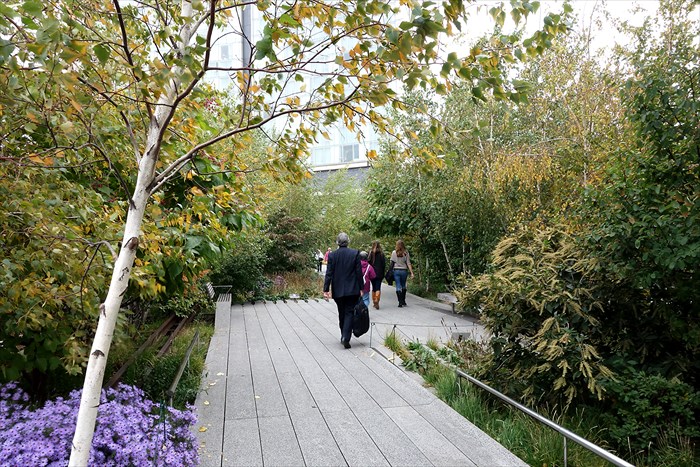 In more ways than one, it was appropriate that we concluded the day by attending Gilles Clement's lecture at the New York Botanical Garden's Mid-Town Center. Clement spoke in heavily accented English. I didn't completely grasp some of the details of the lecture--the Third Landscape--until I got home and read about his theories, but he nevertheless communicated an extraordinarily powerful message through use of simple photos and stories about the nature of nature. The ideas were clear; the label came later.
In more ways than one, it was appropriate that we concluded the day by attending Gilles Clement's lecture at the New York Botanical Garden's Mid-Town Center. Clement spoke in heavily accented English. I didn't completely grasp some of the details of the lecture--the Third Landscape--until I got home and read about his theories, but he nevertheless communicated an extraordinarily powerful message through use of simple photos and stories about the nature of nature. The ideas were clear; the label came later.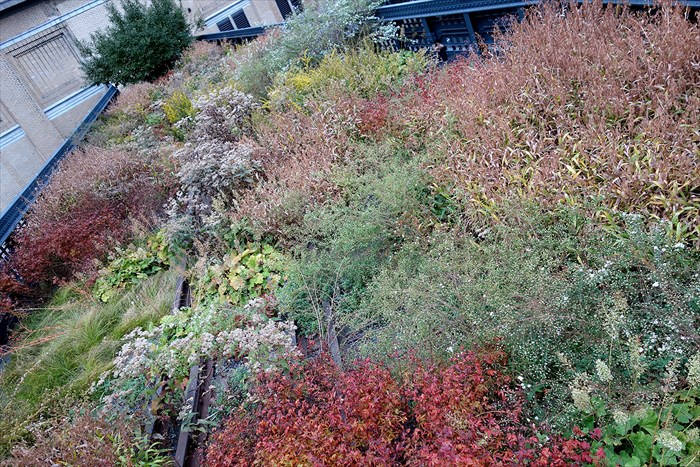 Clement told several simple stories based on observation, using simple snapshots mostly taken years ago.First was a photo of his home garden showing a Giant hogweed (Heracleum mantegazzianum), followed by a second photo with several smaller plants that had seeded into his lawn. Clement responded to this self-seeding of what many consider a noxious weed by changing his garden and allowing the plants to grow. (I perked up on hearing this; I do the same). Why did he let the Giant hogweed grow? Because he liked it! The point of this little parable? Nature knows how to do what it does. Before we intervene, and intervention will certainly be needed at some point, we should give thought to what and why we do it.
Clement told several simple stories based on observation, using simple snapshots mostly taken years ago.First was a photo of his home garden showing a Giant hogweed (Heracleum mantegazzianum), followed by a second photo with several smaller plants that had seeded into his lawn. Clement responded to this self-seeding of what many consider a noxious weed by changing his garden and allowing the plants to grow. (I perked up on hearing this; I do the same). Why did he let the Giant hogweed grow? Because he liked it! The point of this little parable? Nature knows how to do what it does. Before we intervene, and intervention will certainly be needed at some point, we should give thought to what and why we do it. The next image was of an apple tree in his garden. For some reason, the tree fell; its long trunk lay flat on the ground. Clement left it in place, just to see what would happen, altering his mowing pattern to leave an oblong grassy island around the trunk. Then he showed a photo of the trunk regrowing from its base, and another of the mature tree regrown many years later. He was making the point that plants have knowledge. They know what to do without us--a simple idea, but one we don't often give enough attention. Many gardeners fight this knowledge, gardening in opposition to it, "fighting the weeds," when it's equally possible to garden with it.
The next image was of an apple tree in his garden. For some reason, the tree fell; its long trunk lay flat on the ground. Clement left it in place, just to see what would happen, altering his mowing pattern to leave an oblong grassy island around the trunk. Then he showed a photo of the trunk regrowing from its base, and another of the mature tree regrown many years later. He was making the point that plants have knowledge. They know what to do without us--a simple idea, but one we don't often give enough attention. Many gardeners fight this knowledge, gardening in opposition to it, "fighting the weeds," when it's equally possible to garden with it.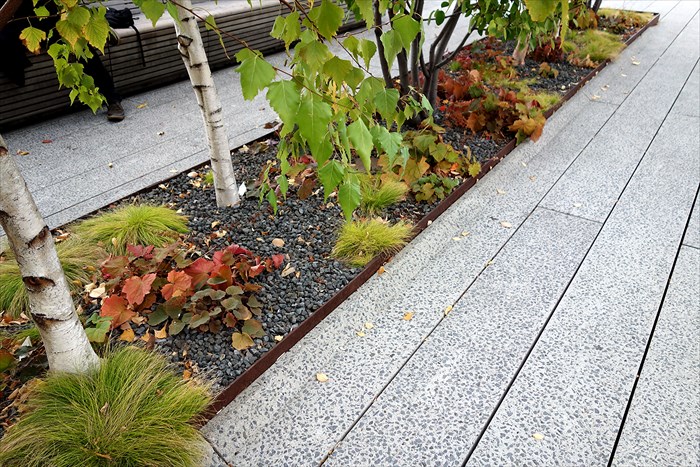 With the third image I imagined we were moving into the unknown, perhaps even the unknowable. The image was a skyward shot of a tree canopy (it brought to mind an abstract fractal pattern). The canopy was made up of several trees, and where they might have met near the center of the photo, a highly irregular linear space clearly demarcated each tree canopy from the other. The trees "knew" not to touch each other. One might even read intention into that not touching. It was quite remarkable to see. Clement called this phenomenon the "fissure of timidity"--an intriguing name--I don't know that he offered further explanation, but it hints at the mysteries visible in plant life if we choose to look. And, of course, it was yet another example of something plants know that we do not know.
With the third image I imagined we were moving into the unknown, perhaps even the unknowable. The image was a skyward shot of a tree canopy (it brought to mind an abstract fractal pattern). The canopy was made up of several trees, and where they might have met near the center of the photo, a highly irregular linear space clearly demarcated each tree canopy from the other. The trees "knew" not to touch each other. One might even read intention into that not touching. It was quite remarkable to see. Clement called this phenomenon the "fissure of timidity"--an intriguing name--I don't know that he offered further explanation, but it hints at the mysteries visible in plant life if we choose to look. And, of course, it was yet another example of something plants know that we do not know.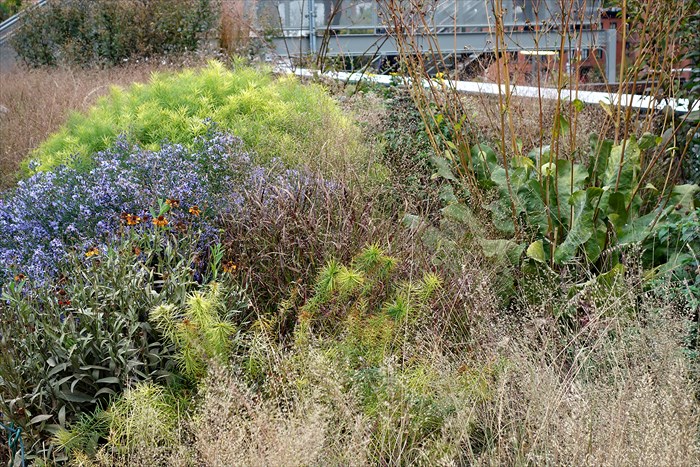 (I am not speaking of the pathetic fallacy; I do not mean to say plants think and have feelings like human beings; their knowledge or intelligence is of a different order entirely--think more of evolutionary traits genetically encoded in responses to environmental stimuli: sunlight, wind, water, soil, nutrients, competition, stress. That still leaves room for a lot of mystery.)I believe Clement was saying that this knowledge that resides in plants is being destroyed as we overdevelop and devour more and more of the planetary landscape for "useful" purposes. Clement identifies areas--which he refers to as The Third Landscape--where potential remains for this knowledge to survive.
(I am not speaking of the pathetic fallacy; I do not mean to say plants think and have feelings like human beings; their knowledge or intelligence is of a different order entirely--think more of evolutionary traits genetically encoded in responses to environmental stimuli: sunlight, wind, water, soil, nutrients, competition, stress. That still leaves room for a lot of mystery.)I believe Clement was saying that this knowledge that resides in plants is being destroyed as we overdevelop and devour more and more of the planetary landscape for "useful" purposes. Clement identifies areas--which he refers to as The Third Landscape--where potential remains for this knowledge to survive.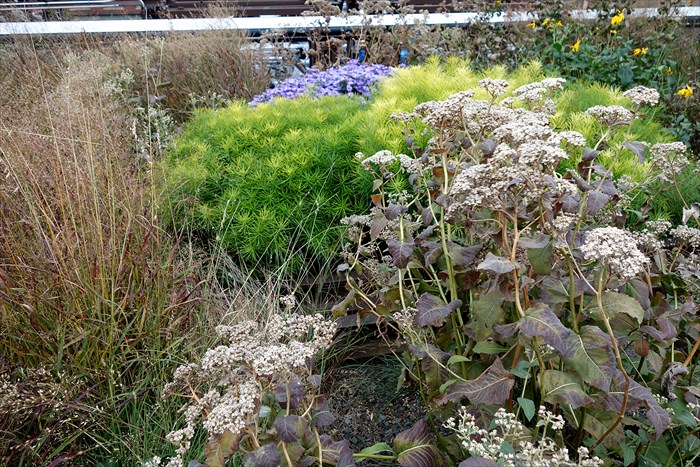 I offer the following from his writings: ..."The Third Landscape - an undetermined fragment of the Planetary Garden - designates the sum of the space left over by man to landscape evolution -- to nature alone. Included in this category are left behind (délaissé) urban or rural sites, transitional spaces, neglected land (friches), swamps, moors, peat bogs, but also roadsides, shores, railroad embankments, etc. To these unattended areas can be added space set aside, reserves in themselves: inaccessible places, mountain summits, non-cultivatable areas, deserts; institutional reserves: national parks, regional parks, nature reserves.
I offer the following from his writings: ..."The Third Landscape - an undetermined fragment of the Planetary Garden - designates the sum of the space left over by man to landscape evolution -- to nature alone. Included in this category are left behind (délaissé) urban or rural sites, transitional spaces, neglected land (friches), swamps, moors, peat bogs, but also roadsides, shores, railroad embankments, etc. To these unattended areas can be added space set aside, reserves in themselves: inaccessible places, mountain summits, non-cultivatable areas, deserts; institutional reserves: national parks, regional parks, nature reserves. "Compared to the territories submitted to the control and exploitation by man, the Third Landscape forms a privileged area of receptivity to biological diversity. Cities, farms and forestry holdings, sites devoted to industry, tourism, human activity, areas of control and decision permit diversity and, at times, totally exclude it. The variety of species in a field, cultivated land, or managed forest is low in comparison to that of a neighboring (unattended) space...
"Compared to the territories submitted to the control and exploitation by man, the Third Landscape forms a privileged area of receptivity to biological diversity. Cities, farms and forestry holdings, sites devoted to industry, tourism, human activity, areas of control and decision permit diversity and, at times, totally exclude it. The variety of species in a field, cultivated land, or managed forest is low in comparison to that of a neighboring (unattended) space...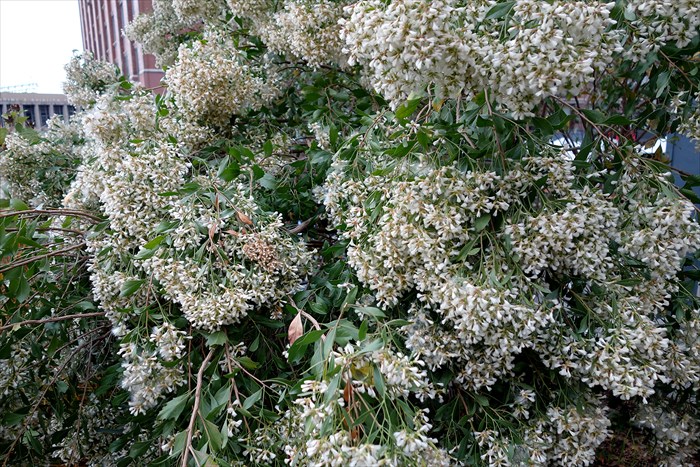 "From this point of view, the Third Landscape can be considered as the genetic reservoir of the planet, the space of the future…"Viewing the Third Landscape as a biological necessity, conditioning the future of living things, modifies the interpretation of territory and enhances areas usually looked upon as negligible. It is up to the political body to organize ground division in such a manner as to assume responsibility for these undetermined areas, tantamount to concern for the future (italics mine)."
"From this point of view, the Third Landscape can be considered as the genetic reservoir of the planet, the space of the future…"Viewing the Third Landscape as a biological necessity, conditioning the future of living things, modifies the interpretation of territory and enhances areas usually looked upon as negligible. It is up to the political body to organize ground division in such a manner as to assume responsibility for these undetermined areas, tantamount to concern for the future (italics mine)."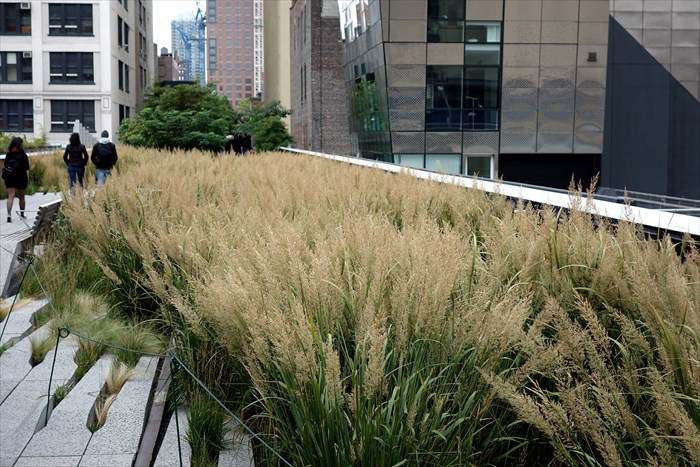 Isn't this what the High Line is doing? Has been doing for more than four years?
Isn't this what the High Line is doing? Has been doing for more than four years? Having just spent several hours on the High Line, which had begun as an elevated railway line on which wild vegetation had spontaneously established itself over decades of abandonment, I grasped Clement's idea of the Third Landscape with a renewed understanding and a sense of surprise. Not a new idea, certainly, but a new way of conceptualizing, of understanding, something many of us have been doing all along. It's helpful to see an old thing presented in a new context.I had to leave immediately on conclusion of the lecture, so I didn't know Michael's reaction until I received an email from him several days later.Besides his own remarkable home garden, far more formal than mine, and designed with intense deliberation, Michael is responsible for designing and managing volunteer maintenance of the public parks in Peterborough, New Hampshire, which he does as a volunteer himself (your can see photos on his blog The Gardener's Eye). Many years ago he developed a friendship with Lynden B. Miller, who did much the same for parks in New York City, and in the intervening years he has sought her advice on how to create and maintain a similar parks program in his own town. As I hurried off to my appointment, he spotted Lynden near the front and headed down to speak to her. Michael and Lynden may or may not want to grow Giant hogweed in their gardens, but I think they understand why some gardeners would.So I watched a bit of magic spring from the sharing of ideas. On his drive to and from Peterborough, Michael took the opportunity to get in a raft of garden touring. In an email titled 'Brine, Clement, High Line, Lynden Miller,' Michael wrote, "Visting the new NYBG Native Garden, Lynden's work, the High Line and the Brine Garden were the perfect complement to the Clement lecture. My head is spinning a bit, but I can feel more evolution coming in the public parks in Peterborough, which is very exciting.""The Brine Garden was very interesting, especially after seeing the Clement lecture... They let trees fall over and shrubs that were smashed are growing new vertical stems ... it is very much like what Clement was doing in his own garden. There are lots of wet paths that are muddy and steep hills with gravel paths without steps which are very difficult to negotiate. I would have liked it much less a week earlier before hearing the lecture." Clement's lecture changed how Michael appreciated this garden. Point taken!
Having just spent several hours on the High Line, which had begun as an elevated railway line on which wild vegetation had spontaneously established itself over decades of abandonment, I grasped Clement's idea of the Third Landscape with a renewed understanding and a sense of surprise. Not a new idea, certainly, but a new way of conceptualizing, of understanding, something many of us have been doing all along. It's helpful to see an old thing presented in a new context.I had to leave immediately on conclusion of the lecture, so I didn't know Michael's reaction until I received an email from him several days later.Besides his own remarkable home garden, far more formal than mine, and designed with intense deliberation, Michael is responsible for designing and managing volunteer maintenance of the public parks in Peterborough, New Hampshire, which he does as a volunteer himself (your can see photos on his blog The Gardener's Eye). Many years ago he developed a friendship with Lynden B. Miller, who did much the same for parks in New York City, and in the intervening years he has sought her advice on how to create and maintain a similar parks program in his own town. As I hurried off to my appointment, he spotted Lynden near the front and headed down to speak to her. Michael and Lynden may or may not want to grow Giant hogweed in their gardens, but I think they understand why some gardeners would.So I watched a bit of magic spring from the sharing of ideas. On his drive to and from Peterborough, Michael took the opportunity to get in a raft of garden touring. In an email titled 'Brine, Clement, High Line, Lynden Miller,' Michael wrote, "Visting the new NYBG Native Garden, Lynden's work, the High Line and the Brine Garden were the perfect complement to the Clement lecture. My head is spinning a bit, but I can feel more evolution coming in the public parks in Peterborough, which is very exciting.""The Brine Garden was very interesting, especially after seeing the Clement lecture... They let trees fall over and shrubs that were smashed are growing new vertical stems ... it is very much like what Clement was doing in his own garden. There are lots of wet paths that are muddy and steep hills with gravel paths without steps which are very difficult to negotiate. I would have liked it much less a week earlier before hearing the lecture." Clement's lecture changed how Michael appreciated this garden. Point taken!
There may be changes coming to the parks in Peterborough next year--a more naturalistic approach in some areas (a bit of The Third Landscape in New Hampshire?). Michael continued, "Clement's park in Paris and the different levels of 'tailored-to-wild' remind me of the different intentions I have in the parks in Peterborough," reminding me that Clement had stressed the need for 'reassurance' in parks and public gardens to 'tell' users the space is intended for public use, that it is not entirely wild ... "My wildest space is Teixeira Park," he explained. "I have been toying with the idea of letting the grass grow in large areas of that park. I've been thinking about it for a while now. The Clement lecture has given me more courage to try it. I would cut it in a way that left a large area where you could play soccer for instance. I think I could make paths in the long grass and make the wild seem organized in a way that would be reassuring. I don't know what to do with the grass--just let whatever grows there, grow. I would certainly want a meadow, which needs to be cut yearly, and would not let it grow into a forest."Recall Clement's statement, "It is up to the political body to organize ground division in such a manner as to assume responsibility for these undetermined areas, tantamount to concern for the future." Michael is doing this. The High Line is doing this. The Brine Garden is doing this. How may of us are doing this?(On the other side of the world, Dan Pearson was concerned with very much the same thing at the Tokachi Millenium Forest in Japan, where he designed a zone of cultivated, though naturalistic-appearing, perennial plantings to gradually introduce visitors to the experience of the less controlled, 'wilder' nature of the forest beyond.)
Michael's philosophical, and very practical, response to Clement's lecture calls to mind that haunting image of the 'fissure of timidity,' the mysterious line of separation between the canopies of the trees Clement presented in his lecture--not because it is applicable directly to garden or park design--though it may well be--but because it reminds us that we need to pay attention. Knowledge is available to us, though frequently the visible remains invisible. It's so familiar, we can't see it, we're predisposed to see the world in limited, constrained ways.
We need a Gilles Clement to point his finger at the obvious.
